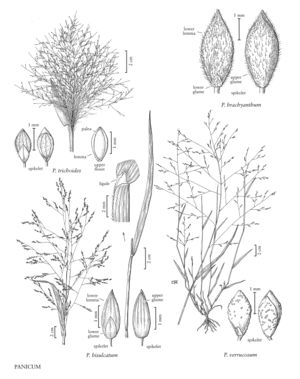Difference between revisions of "Panicum brachyanthum"
FNA>Volume Importer |
imported>Volume Importer |
||
| (8 intermediate revisions by 2 users not shown) | |||
| Line 4: | Line 4: | ||
|publications= | |publications= | ||
|common_names=Prairie panicgrass | |common_names=Prairie panicgrass | ||
| + | |special_status={{Treatment/ID/Special_status | ||
| + | |code=E | ||
| + | |label=Endemic | ||
| + | }} | ||
|basionyms= | |basionyms= | ||
|synonyms= | |synonyms= | ||
| Line 17: | Line 21: | ||
-->{{Treatment/Body | -->{{Treatment/Body | ||
|distribution=Ark.;Okla.;Tex.;Miss.;La. | |distribution=Ark.;Okla.;Tex.;Miss.;La. | ||
| − | |discussion=<p>Panicum brachyanthum grows in dry, sandy or clayey soils of open areas, remnant prairies, woodland borders, and roadsides and, less commonly, along the margins of bogs and on grassy shores in the western portion of the gulf coast plain. It is restricted to the southern United States. It resembles P. verrucosum in its growth habit, but is more restricted in its distribution.</p> | + | |discussion=<p><i>Panicum brachyanthum</i> grows in dry, sandy or clayey soils of open areas, remnant prairies, woodland borders, and roadsides and, less commonly, along the margins of bogs and on grassy shores in the western portion of the gulf coast plain. It is restricted to the southern United States. It resembles <i>P. verrucosum</i> in its growth habit, but is more restricted in its distribution.</p> |
|tables= | |tables= | ||
|references= | |references= | ||
| Line 26: | Line 30: | ||
-->{{#Taxon: | -->{{#Taxon: | ||
name=Panicum brachyanthum | name=Panicum brachyanthum | ||
| − | |||
|authority=Steud. | |authority=Steud. | ||
|rank=species | |rank=species | ||
| Line 33: | Line 36: | ||
|basionyms= | |basionyms= | ||
|family=Poaceae | |family=Poaceae | ||
| + | |illustrator=Linda A. Vorobik;Cindy Roché | ||
| + | |illustration copyright=Utah State University | ||
|distribution=Ark.;Okla.;Tex.;Miss.;La. | |distribution=Ark.;Okla.;Tex.;Miss.;La. | ||
|reference=None | |reference=None | ||
|publication title= | |publication title= | ||
|publication year= | |publication year= | ||
| − | |special status= | + | |special status=Endemic |
| − | |source xml=https:// | + | |source xml=https://bitbucket.org/aafc-mbb/fna-data-curation/src/200273ad09963decb8fc72550212de541d86569d/coarse_grained_fna_xml/V25/V25_1303.xml |
|subfamily=Poaceae subfam. Panicoideae | |subfamily=Poaceae subfam. Panicoideae | ||
|tribe=Poaceae tribe Paniceae | |tribe=Poaceae tribe Paniceae | ||
Latest revision as of 18:56, 11 May 2021
Plants annual; weak, ascending or spreading. Culms slender, wiry, glabrous, often with minute purple streaks and dots, ascending from a decumbent base, often branching extensively at the base and rooting at the lower nodes. Sheaths usually shorter than the internodes, glabrous, margins short-ciliate; ligules usually less than 0.3 mm, membranous, erose, ciliate; blades 4-15 cm long (rarely longer), 2-3 mm wide, flat or slightly involute, glabrous on both surfaces, margins scabridulous, especially towards the apices, bases narrowed. Panicles 4-17 cm, 1/2 to nearly as wide as long; branches few, capillary, ascending or spreading, scabridulous, with a few spikelets distally; pedicels 0.5-10 mm. Spikelets 3.2-4 mm long, about 1.5 mm wide, broadly ellipsoid or obovoid, tuberculate, hispid, faintly veined, acute or acuminate at the apices. Lower glumes usually less than 1 mm, obtuse or acute; upper glumes and lower lemmas subequal, distinctly tuberculate, hispid, with stiff hairs arising from wartlike bases; upper florets 2.7-3.2 mm long, 1.3-1.6 mm wide, obovoid or ellipsoid, nearly smooth, minutely papillose, or cross-rugulose, subacute to acute. 2n = unknown.
Distribution
Ark., Okla., Tex., Miss., La.
Discussion
Panicum brachyanthum grows in dry, sandy or clayey soils of open areas, remnant prairies, woodland borders, and roadsides and, less commonly, along the margins of bogs and on grassy shores in the western portion of the gulf coast plain. It is restricted to the southern United States. It resembles P. verrucosum in its growth habit, but is more restricted in its distribution.
Selected References
None.
